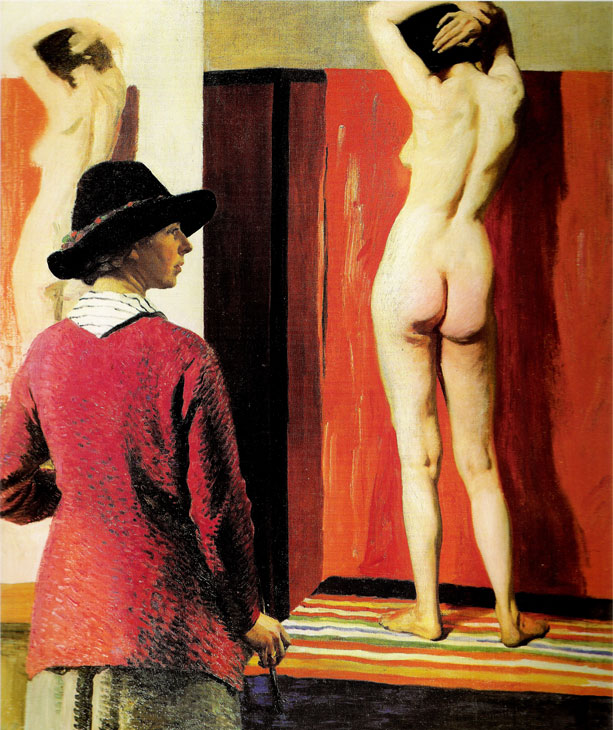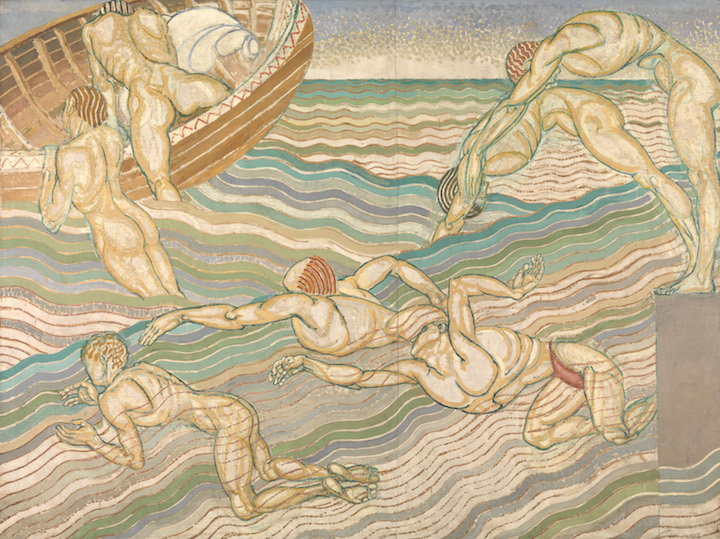In ‘Song of the Swimmer’, a poem published last year for the first time but written in the 19th century, John Addington Symonds describes watching a young man undress to swim in the Serpentine. Beneath clothes ‘soiled with labour’, this ‘young rough’ is ‘like an athlete, like a | Greek hero, like Heracles or Hermes’. His beauty, however, is at least in part contingent or circumstantial: ‘Swimmers’ are ‘all beautiful’, Symonds’s speaker says, ‘in the early | sunshine, under the fresh trees; scattering dewdrops from the herbage, | tossing gold-dust from buttercups’. It takes an unclouded eye to see ‘the god in him’, though viewing the swimmer as a god partially protects Symonds from articulating any earthlier passion. In a sort of verbal striptease, Symonds’ language at once veils and accentuates queer desire.
The chemistry generated by this mixture of veiled intent and unbuttoned disclosure is a focus of Tate Britain’s new exhibition, ‘Queer British Art’. It is both a condition of, and a thematic current connecting, the works on display here, from Noël Coward’s monogrammed dressing gown, to the overwhelmingly beautiful fan Charles Ricketts made for Edith Cooper and Katherine Bradley (aka Michael Field), to Laura Knight’s Self-portrait (1913), which a reviewer for the Telegraph at the time found repulsive on grounds of its combination of ‘dullness’ and ‘something dangerously close to vulgarity’.
Self portrait (1913), Laura Knight. National Portrait Gallery (London, UK)

Throughout the exhibition, curator Clare Barlow manages the difficult task of both registering the background of homophobia against which these works took shape, and keeping the desires and pleasures offered and captured by the works themselves in view. Curatorial labour is especially important here since so much of what Barlow includes does not contain overt depictions of same-sex desire, which often only emerges in the context of the narratives woven around the images and objects.
Frederic Leighton, for example, saw at once what a contemporary viewer probably wouldn’t: that Alessandro de Marco had posed, instead of a female model, for Walter Crane’s The Renaissance of Venus (1877) remarking, ‘That’s not Aphrodite – that is Alessandro!’ We are told elsewhere that Edmund Gosse, who remained closeted throughout his life, took a packet of Wilhelm von Gloeden’s photographs of nude youths, given to him by Symonds, to Robert Browning’s funeral where, ‘with George Meredith at my side, I peeped at it again and again’. Much later, looking again is precisely what Kenneth Halliwell and Joe Orton’s creatively defaced book jackets (‘Knickers Must Fall’ for Night Must Fall, or ‘Fucked by Monty’ for Light of Heart) invite the viewer to do.
Bathing (1911), Duncan Grant. © Tate

At other times, the curators invite us to look twice by returning to the same themes in different contexts. Henry Scott Tuke’s The Critics (1927) shows a group of young men on the shore watching another man swim toward them. The viewer looks on from behind the reclining figures, sharing their perspective without being able to see much for him- or herself. Tuke had been elected to the Royal Academy in 1914, and he presented A Bathing Group (1914), which shows a nude bather reminiscent of a Greek god, for his Diploma Work. Yet, when Duncan Grant introduced an all-male bathing scene into the working-class context of the Borough Polytechnic, the press was inclined to view it as a threat. Grant’s Bathing (1911), a depiction of the swimmers at the Serpentine, was called a ‘nightmare’ by the National Review, which suspected the painting of exerting a ‘degenerative’ influence on the Polytechnic’s students.
‘Queer British Art’ ends with works by Francis Bacon and David Hockney, and with a legal milestone: the decriminalisation of homosexuality in England and Wales in 1967. This exhibition is most notable, however, for tracing an extraordinarily rich range of queer artistic and performance strategies during a period when it is often assumed that investment in queer identities and desires had to be coded or veiled.
‘Queer British Art, 1861–1967’ is at Tate Britain, London, until 1 October.



